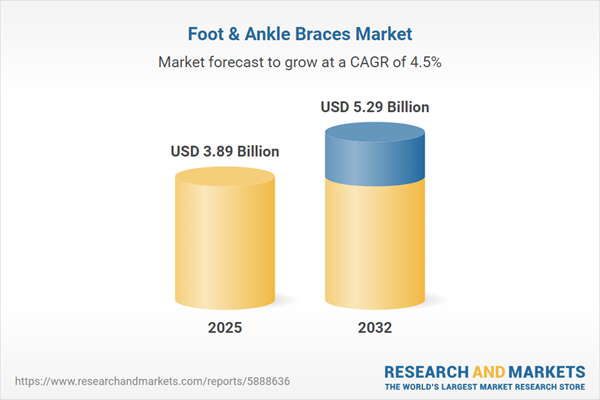Speak directly to the analyst to clarify any post sales queries you may have.
Senior leaders navigating the foot and ankle braces market encounter a dynamic landscape where evolving clinical standards, digital transformation, and shifting compliance requirements converge. Strategic insight into technological innovation, operational trends, and regulatory dynamics is essential to driving adaptive growth and securing a lead within the orthotics sector.
Market Snapshot: Strategic Overview of the Foot and Ankle Braces Market
The global foot and ankle braces market demonstrates strong momentum, with growth supported by increasing musculoskeletal health awareness and the swift uptake of advanced orthotic technologies. Digitalization is reshaping established clinical workflows, equipping healthcare professionals with enhanced digital tools that enable more precise and patient-centric care inside and beyond traditional settings. Market leaders emphasize the integration of automation, innovative materials, and seamless digital interfaces to achieve product personalization and drive patient engagement. As stakeholder expectations align toward individualized solutions and compliance standards evolve, organizations that prioritize agility and forward-looking development maintain the competitive edge necessary in this sector.
Scope & Segmentation of the Foot and Ankle Braces Market
- Product Types: Functional braces, prophylactic options, rehabilitation braces, dynamic orthoses, rigid and semi-rigid solutions, and specialized preventive or recovery braces all address distinct clinical scenarios while allowing customizable care pathways.
- Distribution Channels: Pharmacies, drug stores, hospital clinics, orthopedic offices, and online platforms deliver efficient product access, ensuring timely delivery and broad market coverage across healthcare environments.
- Application Areas: Orthotic devices address correction, rehabilitation, stabilization, and post-surgical recovery, increasingly benefiting from digital monitoring and telemedicine compatibility to enhance patient outcomes.
- Material Types: Braces leverage various materials including traditional fabrics, metals, neoprene, advanced polymers, smart textiles, and composites, delivering a balance of durability, adaptability, and comfort across use environments.
- End User Groups: Solutions cater to both adults and pediatric populations, enabling routine care, targeted interventions, and preventive strategies for a wide range of patient needs.
- Price Tiers: Product offerings range from value-based and budget-conscious options to technologically advanced, premium-grade braces, giving providers and institutions flexibility based on operational and clinical requirements.
- Regional Markets: The Americas, Europe, Middle East & Africa, and Asia-Pacific each present unique market access challenges and compliance factors, requiring regionally tailored business and regulatory strategies.
- Industry Leaders: Companies such as DJO LLC, Össur hf, Breg Inc., DeRoyal Industries, BSN Medical GmbH, Medi GmbH & Co. KG, Bauerfeind AG, Stryker Corporation, Ottobock SE & Co. KGaA, and Darco International, Inc. actively influence sector priorities and overall market direction.
Key Takeaways for Senior Decision-Makers
- Advanced manufacturing, including the use of 3D printing and smart sensors, supports tailored treatments and enhances the scope for patient-specific solutions.
- Collaboration between clinical, engineering, and IT teams aligns device development with evolving care models, empowering greater patient participation in therapy.
- Expansion of digital distribution and direct-to-patient channels streamlines logistics, broadens market reach, and underpins adaptive care delivery strategies.
- Business models should incorporate shifts in regulatory and reimbursement frameworks as remote monitoring and digital health become increasingly aligned with therapeutic practices.
- Ongoing investment in research and development, strategic alliances, and targeted acquisitions underpins continuous product advancement and supports competitive positioning.
Tariff Impact: Evolving Cost Structures in 2025
- New U.S. tariffs on manufacturing inputs prompt organizations to optimize supply chains, assess nearshoring, and reinforce cost and supply stability strategies.
- Greater use of bio-based and alternative materials supports sustainability while upholding product integrity and maintaining procurement oversight.
- Adoption of distributed, lean manufacturing enables faster responses to regulatory shifts and variable regional pressures.
Methodology & Data Sources
This analysis integrates comprehensive secondary research with targeted patent reviews, regulatory assessments, and industry expert interviews. Findings undergo rigorous external peer review, ensuring reliable and sector-relevant insights for executive decision-makers in the foot and ankle braces market.
Why This Report Matters
- Enables senior executives to monitor innovation drivers, key regulatory changes, and evolving models of care specific to the foot and ankle braces market.
- Offers actionable segmentation to inform capital planning and sharpen operational alignment for providers and patient-focused organizations.
- Equips organizations to anticipate shifts in supply strategy and leverage advancements in both technology and distribution for long-term, sustainable market presence.
Conclusion
This analysis empowers senior leaders to adapt strategies, drive operational efficiency, and enhance competitive standing amid continual change in the foot and ankle braces industry.
Additional Product Information:
- Purchase of this report includes 1 year online access with quarterly updates.
- This report can be updated on request. Please contact our Customer Experience team using the Ask a Question widget on our website.
Table of Contents
3. Executive Summary
4. Market Overview
7. Cumulative Impact of Artificial Intelligence 2025
Companies Mentioned
The companies profiled in this Foot & Ankle Braces market report include:- DJO LLC
- Össur hf
- Breg, Inc.
- DeRoyal Industries, LLC
- BSN Medical GmbH
- Medi GmbH & Co. KG
- Bauerfeind AG
- Stryker Corporation
- Ottobock SE & Co. KGaA
- Darco International, Inc.
Table Information
| Report Attribute | Details |
|---|---|
| No. of Pages | 193 |
| Published | November 2025 |
| Forecast Period | 2025 - 2032 |
| Estimated Market Value ( USD | $ 3.89 Billion |
| Forecasted Market Value ( USD | $ 5.29 Billion |
| Compound Annual Growth Rate | 4.5% |
| Regions Covered | Global |
| No. of Companies Mentioned | 11 |









